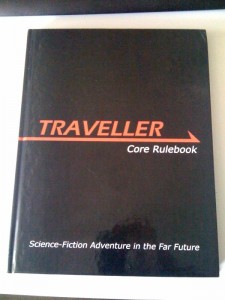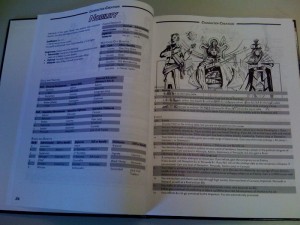Please note: This is a first look, not a proper review. I haven’t read the whole book yet and I just write about my initial thoughts. So please take everything written here with a grain of salt.
Traveller was the first roleplaying game I ever ran as a GM and this Saturday I finally got a copy of the 2008 core rulebook by Mongoose Publishing. Usually the book costs $39.95 for the 192-page hardcover book, which is quite expensive (you can get a PDF copy for $27.96 at RPGNow). That’s why I ordered a “damaged” copy over the German Amazon Marketplace for mere €6 that turned out to be of almost perfect condition. 🙂
Traveller is one of the oldest roleplaying game series in existence and was created in 1977 by Marc Miller. The latest version created by Mongoose Publishing in 2008 is surprisingly close to the original. As in the original game you gave to roll 2d6 when a character tries to succeed in a task. Appropriate modifiers (like Attribute and Skill modifiers) are added and you succeed when your result beats a given target number. For example Dex 8+ means, you have to roll 2d6 add your Dex modifier. A roll of 8 or more is a success.
The character creation system is definitely a highlight of the system. After you’ve rolled up your basic stats and decided which planet you’re from (which gives the character some appropriate starting skills) you can enlist in one of several careers. But choosing a career is not like choosing a class in D&D for example. Traveller uses a lifepath system that not only generates your character’s traits but also provides the character with a background. It’s possible to change careers by choice or by fate (you have to roll to reenlist for any career) and certain mishaps and life events can happen. In the original Traveller it was possible that a character died during character creation. Now the worst that can happen is that the character is wounded and has to enlist into a different service for his next 4-year term.
When I remember correctly the original Traveller had only a few careers including Scout, Merchant, Navy and Army. Mongoose expanded that list by the following careers: Agent, Citizen, Drifter, Entertainer, Marines, Nobility, Rogue, Scholar and Psion. Aside from the lifepath system there are also alternate character creation rules that allow you to use a point-buy system.
Another favorite part of the book is the Spacecraft Design chapter. The spacecraft design rules look easy enough to come up with a couple of spaceship designs in a few hours and is definitely not as detailed as the GURPS Vehicles rules. A nice touch is the addition of alternate drives. Traditionally spaceships in Traveller use the Jump drive, but if you want to use the Traveller rules for a different setting, you can create ships using Warp drives, teleport drives or even hyperspace portals. The rulebook also includes a couple of common spacecraft including full deckplans.
I haven’t had the time to read the whole book but from what I’ve seen so far the Traveller Core Rulebook is a great basis for almost any SF campaign. Although the rulebook uses an implied setting much like the D&D core books, you can easily adapt it to other campaigns than the “Third Imperium”. And if you are a fan of sandbox campaigns you’ll notice that Traveller is a great resource for space-based sandboxes. You get a chapter about encounters (with random encounter tables), a whole chapter on Trade and an extensive world-creation system. Just create a subsector (a section of space of 8 times 10 parsecs) and you’re good to go. A sample subsector map is included.
So, do I recommend Traveller? Hell, yes I do! If you like classic space opera you’ll love the Traveller Core Book. Although it’s only 192-pages long you get a lot of material for your game. And from what I gather you should probably be able to run almost every SF campaign with only a bit of tweaking. If you prefer glossy paper and full-color artwork in your RPG rulebooks you’ll be pretty disappointed with the b/w interior and the pretty bland cover but if you ask me, the classic look has its special charm.



Nice job on finding the bargain. I'm interested on hearing your further thoughts on Mongoose Traveller. It's a solid clean-up of Classic, I thought…
.-= Zachary´s last blog ..Mega-Interview With Kevin Siembieda =-.
When I got the book this Saturday it almost felt like a special birthday present. 🙂
Aside from the dent on the upper-right corner of the front cover it's in perfect condition!
And I am pretty sure I'll write more about Traveller in the future. I've decided to drop PDQ for my Ad Astra campaign and run it using Traveller instead.